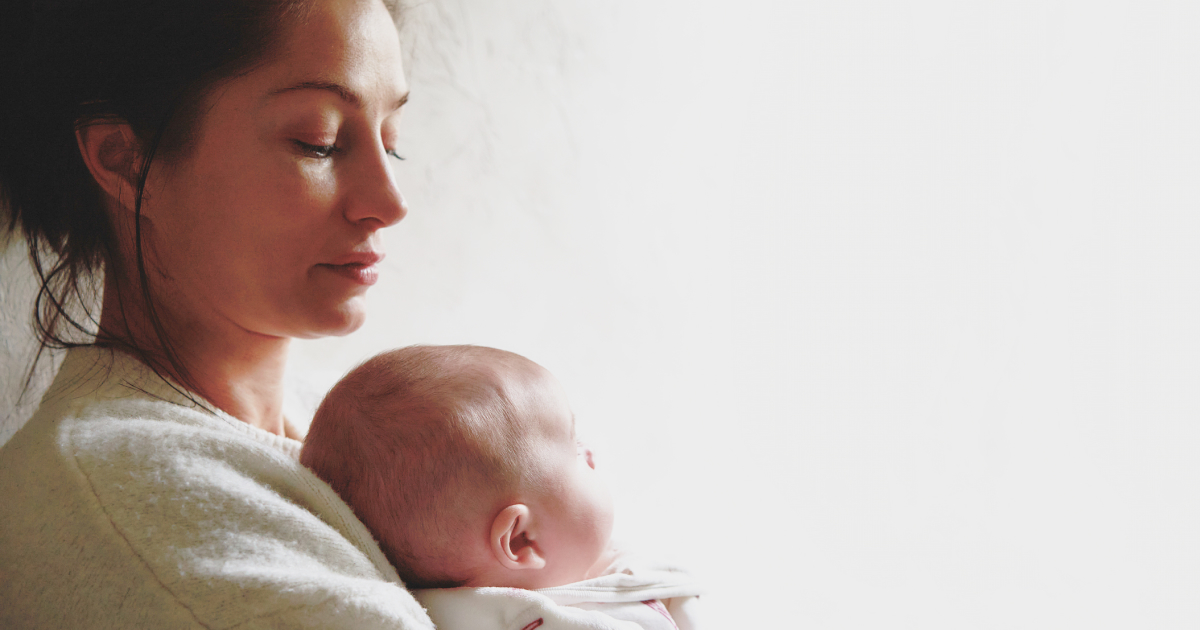There’s this notion that the first weeks of parenthood should be all new-baby bliss and bonding. The reality? This time of immense change can also be an emotional rollercoaster.
Birthing parents are learning to care for their newborns while their bodies are still healing. Their hormones are also recalibrating. And every new mom or dad is likely operating on less sleep than ever before.
The postpartum period can be filled with some of life’s highest highs and lowest lows. Up to 75% of women experience “baby blues,” a period of sadness and anxiousness in the 2 weeks following delivery. But up to 15% experience a longer-lasting, more intense version: postpartum depression (or PPD). And between 11% and 21% of women show signs of postpartum anxiety (or PPA).
Perhaps even more surprising? Research shows that non-birthing partners of any gender can display symptoms of PPD in the year after their baby’s born. (It’s thought that between 7% and 9% of men develop symptoms.) Certain factors can also put adoptive moms at risk for PPD. These might include lack of sleep and past fertility problems.
Both PPA and PPD can come with feelings of guilt and shame. “A lot of times people will talk about not connecting with their baby,” says Giselle Alexander, LCSW, a licensed therapist and AbleTo program advisor. “I’m supposed to love this baby and be so excited. Why don’t I have the same joy that other parents have?”
But the truth is, these conditions are common among new parents. They can happen to anyone, and they are no one’s fault. Most importantly, they can be treated once the symptoms are spotted.
You’ll likely get asked some questions at your postpartum checkup to gauge your mood. And your child’s pediatrician may screen for postpartum depression and anxiety, too. But it also helps if you know what to look for yourself.
We’ll go over what the conditions are, as well as common symptoms and risk factors. Then we’ll talk about how to get help — both before birth and postpartum.

Achieve your mental wellness goals
AbleTo programs give you 24/7 access to tools, activities, and content tailored to your needs. Sign up or log in to start exploring.

What are postpartum depression and anxiety?
Postpartum depression and anxiety share many of the same symptoms as their more general forms. The main difference is when the symptoms occur. Postpartum depression and anxiety occur anytime in the year after birth.
Symptoms of PPD can vary from person to person. The most common include:
- Low mood or mood swings
- Crying more than usual
- Withdrawing from family and friends
- Loss of appetite or excess hunger
- Lack of interest in activities you used to enjoy
- Feeling irritable, angry, or worthless
- Trouble sleeping (or sleeping too much)
- Trouble thinking clearly, focusing, or making decisions
- Trouble bonding with your baby
- Fearing you’re not a good parent
- Thoughts of harming yourself or your baby
PPA symptoms can also vary by person. Some common ones to look for are:
- Increased heart rate
- Shortness of breath
- Trouble sitting still
- Lack of appetite
- Feeling tense or on edge
- Racing thoughts
- Avoiding certain activities or places for fear that something bad will happen
- Repeatedly checking things (like, if the baby is breathing)
- Intense need for control
The truth about intrusive thoughts
One of the most jarring symptoms people with PPA and PPD might encounter is when dark, unwanted thoughts or images pop into their brains. These are known as intrusive thoughts. They’re also one of the most common symptoms.
They might show up as a flash of dropping the baby down stairs. Or imagining the baby drowning in a bathtub. They could also be thoughts like, “My baby would be better off without me.”
The feelings behind these thoughts can often be tied to safety and security. “You’re second-guessing your ability to be a provider for your child,” explains Alexander. “Your senses are sharpened to every potential risk. Sometimes your mind can take that a step too far.”
But there are ways to hit the pause button. First, know that you aren’t alone. Many people deal with intrusive thoughts.
Second, try not to judge yourself. Having these thoughts doesn’t make them true. Nor does it make you a bad person.
Once you see them for what they are, you can work to address them. “Monitoring moods and triggers is important,” says Alexander. “You begin to see how your emotions, behaviors, and thoughts influence each other. You can start to spot patterns.”
In addition to a mood tracking tool, AbleTo programs also use a 3Cs Guided Journal. It walks participants through catching, checking, and changing unhelpful thoughts.
What are the risk factors and causes?
PD and PPA can affect anyone. But there are factors that put some people at higher risk.
- History of certain conditions (for example, eating disorders, anxiety, depression)
- Previous miscarriage
- Loss of child
- Lack of support network (such as a partner, friends, family)
- Mixed feelings about your pregnancy
- Difficult pregnancy or delivery
- Having a baby with special needs
- Being a young mom (20 years old or younger)
How are postpartum depression and anxiety treated?
A number of treatments have been shown to help PPA and PPD. The options vary based on which symptoms are showing up and how severe they are.
A few someone might try:
- Therapy. Research shows that both talk therapy and cognitive behavioral therapy can be effective. Providers can help you get to the root of tough emotions. They can also help you work through specific challenges. (AbleTo offers a form of therapy grounded in CBT. You may be eligible to enroll.)
- Medication. A doctor can help determine the best options based on symptoms and how the baby is being fed. (Some of the medication is absorbed into breast milk, but the levels are generally low, so many meds are considered safe for nursing moms.)
- Support groups. Both virtual and in-person new parent groups can provide a space to share worries and challenges. They can create social bonds and help new parents feel less alone in their struggles.
Can postpartum depression and anxiety be prevented?
There’s no perfect way to prevent PPD or PPA, but putting certain measures in place ahead of time can help mitigate symptoms.
- Schedule a check-in. Set up a session or two with a mental health provider for the weeks following your due date. Consider working with someone covered by your health plan to make it more affordable.
- Set realistic expectations. You might have dreamed about the postpartum period being all snuggles and sweetness. And there’s plenty of that. It’s just mixed in with less fun things, like adjusting to broken sleep, deciphering cry types, and juggling a ton of diaper changes. Try not to beat yourself up about how much there is to figure out. Every parent goes through it.
- Establish a plan for visitors. Give yourself time to adjust to your new normal. Lots of people will want to meet the baby, but it’s up to you if and when that happens. Your little family is priority number one. You have every right to do what feels best for you.
- Ask for help or accept help offered. Your “village” might look different than you thought, and that’s okay. People offer to help because they genuinely want to.
- Sleep when you can. If possible, aim to get anchor sleep. That means 4-hour chunks, preferably at a consistent time. This might mean letting other regular responsibilities go to prioritize sleep for a period of time.
- Know that everything is a phase. It’s so hard to remember when you’re in the thick of it, and every day feels like Groundhog’s Day. But you will sleep. And the baby’s sleep will get more structured over time. (They’ll also grow out of that witching-hour crying!)
- Find ways to socialize. Video chat with loved ones. Join new parent groups. Get out of the house for coffee with a friend. These bits of connection will remind you that you have support.
- Gently move your body. When you’re cleared, ease back into your favorite exercise. Bonus points for any activity that involves getting fresh air, like a walk (with or without baby in tow).
- Carve out time for self care. Maybe it’s meditating or drawing. Maybe it’s just reading a (non-parenting!) book. Doing little things that you loved pre-baby will help you feel like you haven’t totally lost yourself.
- Journal. Getting intrusive thoughts out of your head and onto paper is the first step to releasing them. Once you see them, you can start to work through any faulty thinking at play. (AbleTo’s 3Cs Guided Journal can help.)
You’re not alone
Postpartum depression and anxiety are common and can happen to anyone. They’re no one’s fault, and they’re also highly treatable. You don’t have to go it alone.
New parent groups, friends, and family can all help you navigate this challenging time. You can also find support from caring health providers, including the ones at AbleTo.
Getting help benefits the whole family. And you deserve to feel your best.
Need some support?
AbleTo is here to help. From on-demand self care to virtual therapy and coaching, we make managing your mental wellness easy. Sign up and get the personalized support you deserve.
By Sarah Bruning
Sarah Bruning has been a journalist and content strategist for more than 15 years. Her work has appeared in leading publications including Women’s Health, Travel + Leisure, and Cosmopolitan.
Clinically reviewed by Hayley Quinn, PsyD, Manager of Clinical Program Development at AbleTo.
Photos by jacoblund/iStock; ComR78/iStock. Individuals in photographs do not represent AbleTo participants.
The information featured on this site is general in nature. The site provides health information designed to complement your personal health management. It does not provide medical advice or health services and is not meant to replace professional advice or imply coverage of specific clinical services or products. The inclusion of links to other websites does not imply any endorsement of the material on such websites.



